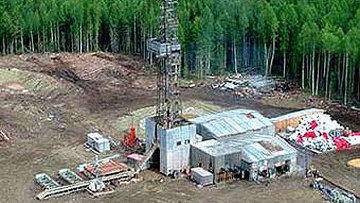
Shtokman Gas Project Postponed: Implications for Russia, Europe and the US
Publication: Eurasia Daily Monitor Volume: 7 Issue: 27
By:

On February 5, the Gazprom-led Shtokman Development Company and operator of the supergiant gas project in the Russian Arctic, announced that investment decisions and field development are being postponed. The investment decision for field work is being rescheduled, from the end of 2010 to late 2011. Decisions on future gas exports by pipeline and in liquefied form are being delayed until March and December 2011, respectively. The start of production for pipeline-delivered gas to Europe will be postponed from 2013 to 2016. And the start of LNG production for export to the United States is postponed from 2014 to 2017.
The joint venture includes Total of France and Norway’s Statoil as minority partners, alongside Gazprom. The board of directors’ announcement alludes in passing to “changing market trends, particularly regarding LNG,” as a reason for delaying the Shtokman project (Interfax, February 5, 6).
From the joint venture’s inception in 2007, many outside observers had regarded the start of commercial production at Shtokman as unlikely to materialize before 2020, considering the physical and financial challenges to this Arctic project. Production costs were expected to raise the price of Shtokman gas exorbitantly. On top of those resilient challenges, the Shtokman project suddenly confronted in 2009 the expansion of globally traded LNG on both sides of the Atlantic, and the development of unconventional gas in the United States.
Thus, a decision to postpone the Shtokman project became unavoidable. If anything, the postponement’s time-frame as declared seems understated. The project may now be regarded as suspended, with a high likelihood of further postponements, given the long-term nature of ongoing market trends. Growing availability of competitively priced Middle Eastern LNG, in parallel with surging US production of unconventional gas, are consigning the Shtokman project to redundancy. Shtokman gas now looks even less attractive commercially to European consumers and is no longer in demand by economic criteria on US markets.
From Moscow’s standpoint, this means lower projections of the overall gas output for the coming decade. Shtokman was the declared top priority for gas field development in Russia; the first major, export-oriented new development (apart from Sakhalin in the Pacific) since the Soviet era. Long-proposed investments in other new Russian fields (Bovanenkovo and other fields in Yamal’s north) have yet to materialize. High investment costs render those Arctic fields even less attractive to international companies after the advent of LNG and unconventional gas.
With Shtokman suspended, and Bovanenkovo development postponed again, the prospect of a Russian gas shortfall in the years ahead (as anticipated also by Gazprom itself, prior to the 2009 recession) is taking on sharper contours.
Shtokman’s halt carries positive implications for Europe from the standpoints of supply diversity and market competition. Pipeline-delivered gas from Shtokman would have further increased European reliance on Russian-delivered gas; and it would boost gas prices through the high-priced Shtokman gas.
One portion of Shtokman’s future output was presumably to be pumped from the Barents Sea, across the Kola Peninsula, into the second line of Gazprom’s Nord Stream pipeline on the Baltic seabed. With the Shtokman project’s halt, the second line of Nord Stream would have to be at least delayed and possibly cancelled. This would depend on Shtokman’s ultimate fate, unless Gazprom re-directs gas volumes from other fields or other consumers to supply Nord Stream’s second line.
Nord Stream was planned to export 55 billion cubic meters (bcm) of gas (at 27.5 bcm through each line), to Germany as prime consumer and the Netherlands and France as lesser consumers. The first stage is planned to become operational by 2015, made possible by multi-billion Euro credit guarantees from the German government. While French and Dutch participation can be regarded as a supply-diversification measure on the national level (though not on the European), Germany’s participation increases the country’s already high dependence on Russian gas, with the attendant political ramifications.
German and other companies that staked their strategies on Russian gas are now trying to escape the constraints of long-term, oil-indexed, take-or-pay contracts with Gazprom. Such obligations, meanwhile, complicate those companies’ efforts to take advantage of the fast-growing spot markets and LNG availability in Europe.
Shtokman gas was a hypothetical source for the Nord Stream pipeline’s second stage. Officially, Russia has not earmarked any gas resources for Nord Stream’s second stage thus far. German consumers and industry would benefit by its demise.
Unconventional gas extraction (from shale and other “hard gas” formations) in the United States is rapidly transforming the international gas trade. The US overtook Russia in 2009 as the world’s leading producer with 624 bcm (Bloomberg, January 13). Unconventional gas has turned the US from a net consumer into a self-sufficient market in 2009, and potentially into a net exporter through LNG.
As recently as mid-2009, Gazprom was advertising its plans to capture a sizeable US market share through LNG from Shtokman. It must now renounce this goal.
Along with LNG development, the globalized gas trade is challenging Gazprom’s business model in Europe. That model was predicated upon continental pipelines, market compartmentalization, long-term dependent partners, captive consumers, and (in recent years) the anticipation of gas becoming a scarce commodity in Europe, to be administered by gas-rich Russia for Europeans. Thus, exorbitant production costs or purchase prices were to be paid to Russia for “access” to its gas. The Shtokman project can now be seen as a relic of that period and its disproved assumptions.




